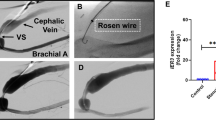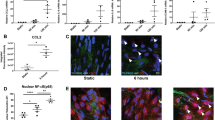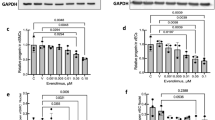Abstract
Poor long-term graft patency remains a major limitation of coronary artery bypass grafting using saphenous vein aortocoronary grafts. Neointimal hyperplasia (NIH) represents the principal mechanism of graft failure; a substantial body of evidence implicates transforming growth factor-β1 (TGF-β1) in the pathogenesis of NIH. The small leucine-rich proteoglycans decorin and fibromodulin possess TGF-β-antagonist activity to differing extents and with differing avidities for the isoforms of TGF-β. We compared their ability to inhibit NIH in an ex vivo model of human saphenous vein organ culture following adenovirus-mediated gene transfer. Surgically prepared human saphenous vein segments received adenovirus expressing fibromodulin (Ad5-Fmod), decorin (Ad5-Dcn), β-galactosidase (Ad5-lacZ) or vehicle-only. Computerized morphometry 14 days after infection revealed significantly reduced neointimal area, neointimal thickness and intima/media ratio in Ad5-Fmod- and Ad5-Dcn-infected veins. Each parameter was significantly smaller in Ad5-Fmod- than in Ad5-Dcn-exposed segments. Fibrillar collagen content and levels of biologically active TGF-β were lower in vessels receiving Ad5-Fmod or Ad5-Dcn than in those receiving Ad5-lacZ or vehicle-only. Fibromodulin is a more potent inhibitor of NIH in cultured human saphenous vein than decorin and offers potential therapeutic benefits in saphenous vein graft failure (and possibly in other forms of accelerated atherosclerosis) by reduction of associated neointima formation.
This is a preview of subscription content, access via your institution
Access options
Subscribe to this journal
Receive 12 print issues and online access
$259.00 per year
only $21.58 per issue
Buy this article
- Purchase on Springer Link
- Instant access to full article PDF
Prices may be subject to local taxes which are calculated during checkout









Similar content being viewed by others
References
Favaloro RG . Critical analysis of coronary artery bypass graft surgery: a 30-year journey. J Am Coll Cardiol 1998; 31: 1B–63B.
Motwani JG, Topol EJ . Aortocoronary saphenous vein graft disease: pathogenesis, predisposition, and prevention. Circulation 1998; 97: 916–931.
Fitzgibbon GM, Kafka HP, Leach AJ, Keon WJ, Hooper GD, Burton JR . Coronary bypass graft fate and patient outcome: angiographic follow-up of 5,065 grafts related to survival and reoperation in 1,388 patients during 25 years. J Am Coll Cardiol 1996; 28: 616–626.
Shuhaiber JH, Evans AN, Massad MG, Geha AS . Mechanisms and future directions for prevention of vein graft failure in coronary bypass surgery. Eur J Cardiothorac Surg 2002; 22: 387–396.
Cox JL, Chiasson DA, Gotlieb AI . Stranger in a strange land: the pathogenesis of saphenous vein graft stenosis with emphasis on structural and functional differences between veins and arteries. Prog Cardiovasc Dis 1991; 34: 45–68.
Bryan AJ, Angelini GD . The biology of saphenous vein graft occlusion: etiology and strategies for prevention. Curr Opin Cardiol 1994; 9: 641–649.
Davis KB, Chaitman B, Ryan T, Bittner V, Kennedy JW . Comparison of 15-year survival for men and women after initial medical or surgical treatment for coronary artery disease: a CASS registry study. Coronary Artery Surgery Study. J Am Coll Cardiol 1995; 25: 1000–1009.
Chamberlain J . Transforming growth factor-beta: a promising target for anti-stenosis therapy. Cardiovasc Drug Rev 2001; 19: 329–344.
Kingston PA, Sinha S, David A, Castro MG, Lowenstein PR, Heagerty AM . Adenovirus-mediated gene transfer of a secreted transforming growth factor-beta type II receptor inhibits luminal loss and constrictive remodeling after coronary angioplasty and enhances adventitial collagen deposition. Circulation 2001; 104: 2595–2601.
Nikol S, Huehns TY, Weir L, Wight TN, Hofling B . Restenosis in human vein bypass grafts. Atherosclerosis 1998; 139: 31–39.
Wolff RA, Ryomoto M, Stark VE, Malinowski R, Tomas JJ, Stinauer MA et al. Antisense to transforming growth factor-beta1 messenger RNA reduces vein graft intimal hyperplasia and monocyte chemotactic protein 1. J Vasc Surg 2005; 41: 498–508.
Isaka Y, Brees DK, Ikegaya K, Kaneda Y, Imai E, Noble NA et al. Gene therapy by skeletal muscle expression of decorin prevents fibrotic disease in rat kidney. Nat Med 1996; 2: 418–423.
Giri SN, Hyde DM, Braun RK, Gaarde W, Harper JR, Pierschbacher MD . Antifibrotic effect of decorin in a bleomycin hamster model of lung fibrosis. Biochem Pharmacol 1997; 54: 1205–1216.
Hildebrand A, Romaris M, Rasmussen LM, Heinegard D, Twardzik DR, Border WA et al. Interaction of the small interstitial proteoglycans biglycan, decorin and fibromodulin with transforming growth factor beta. Biochem J 1994; 302 (Part 2): 527–534.
Stoff A, Rivera AA, Mathis JM, Moore ST, Banerjee NS, Everts M et al. Effect of adenoviral mediated overexpression of fibromodulin on human dermal fibroblasts and scar formation in full-thickness incisional wounds. J Mol Med 2007; 85: 481–496.
Fischer JW, Kinsella MG, Clowes MM, Lara S, Clowes AW, Wight TN . Local expression of bovine decorin by cell-mediated gene transfer reduces neointimal formation after balloon injury in rats. Circ Res 2000; 86: 676–683.
Nili N, Cheema AN, Giordano FJ, Barolet AW, Babaei S, Hickey R et al. Decorin inhibition of PDGF-stimulated vascular smooth muscle cell function: potential mechanism for inhibition of intimal hyperplasia after balloon angioplasty. Am J Pathol 2003; 163: 869–878.
Kingston PA, Sinha S, Appleby CE, David A, Verakis T, Castro MG et al. Adenovirus-mediated gene transfer of transforming growth factor-beta3, but not transforming growth factor-beta1, inhibits constrictive remodeling and reduces luminal loss after coronary angioplasty. Circulation 2003; 108: 2819–2825.
Soo C, Hu FY, Zhang X, Wang Y, Beanes SR, Lorenz HP et al. Differential expression of fibromodulin, a transforming growth factor-beta modulator, in fetal skin development and scarless repair. Am J Pathol 2000; 157: 423–433.
Appleby CE, Kingston PA, David A, Gerdes CA, Umana P, Castro MG et al. A novel combination of promoter and enhancers increases transgene expression in vascular smooth muscle cells in vitro and coronary arteries in vivo after adenovirus-mediated gene transfer. Gene Therapy 2003; 10: 1616–1622.
Abe M, Harpel JG, Metz CN, Nunes I, Loskutoff DJ, Rifkin DB . An assay for transforming growth factor-beta using cells transfected with a plasminogen activator inhibitor-1 promoter-luciferase construct. Anal Biochem 1994; 216: 276–284.
Geng Y, McQuillan D, Roughley PJ . SLRP interaction can protect collagen fibrils from cleavage by collagenases. Matrix Biol 2006; 25: 484–491.
Hedlund H, Mengarelli-Widholm S, Heinegard D, Reinholt FP, Svensson O . Fibromodulin distribution and association with collagen. Matrix Biol 1994; 14: 227–232.
Ruhland C, Schonherr E, Robenek H, Hansen U, Iozzo RV, Bruckner P et al. The glycosaminoglycan chain of decorin plays an important role in collagen fibril formation at the early stages of fibrillogenesis. FEBS J 2007; 274: 4246–4255.
Chamberlain J, Gunn J, Francis SE, Holt CM, Arnold ND, Cumberland DC et al. TGFbeta is active, and correlates with activators of TGFbeta, following porcine coronary angioplasty. Cardiovasc Res 2001; 50: 125–136.
Hishikawa K, Nakaki T, Fujii T . Transforming growth factor-beta(1) induces apoptosis via connective tissue growth factor in human aortic smooth muscle cells. Eur J Pharmacol 1999; 385: 287–290.
D’Antoni ML, Torregiani C, Ferraro P, Michoud MC, Mazer B, Martin JG et al. Effects of decorin and biglycan on human airway smooth muscle cell proliferation and apoptosis. Am J Physiol Lung Cell Mol Physiol 2008; 294: L764–L771.
Wadhwa S, Embree M, Ameye L, Young MF . Mice deficient in biglycan and fibromodulin as a model for temporomandibular joint osteoarthritis. Cells Tissues Organs 2005; 181: 136–143.
Vallat L, Magdelenat H, Merle-Beral H, Masdehors P, Potocki de Montalk G, Davi F et al. The resistance of B-CLL cells to DNA damage-induced apoptosis defined by DNA microarrays. Blood 2003; 101: 4598–4606.
Smith JD, Bryant SR, Couper LL, Vary CP, Gotwals PJ, Koteliansky VE et al. Soluble transforming growth factor-beta type II receptor inhibits negative remodeling, fibroblast transdifferentiation, and intimal lesion formation but not endothelial growth. Circ Res 1999; 84: 1212–1222.
Yamamoto K, Morishita R, Tomita N, Shimozato T, Nakagami H, Kikuchi A et al. Ribozyme oligonucleotides against transforming growth factor-beta inhibited neointimal formation after vascular injury in rat model: potential application of ribozyme strategy to treat cardiovascular disease. Circulation 2000; 102: 1308–1314.
Coats Jr WD, Whittaker P, Cheung DT, Currier JW, Han B, Faxon DP . Collagen content is significantly lower in restenotic versus nonrestenotic vessels after balloon angioplasty in the atherosclerotic rabbit model. Circulation 1997; 95: 1293–1300.
Ichii T, Koyama H, Tanaka S, Kim S, Shioi A, Okuno Y et al. Fibrillar collagen specifically regulates human vascular smooth muscle cell genes involved in cellular responses and the pericellular matrix environment. Circ Res 2001; 88: 460–467.
Stringa E, Knauper V, Murphy G, Gavrilovic J . Collagen degradation and platelet-derived growth factor stimulate the migration of vascular smooth muscle cells. J Cell Sci 2000; 113 (Part 11): 2055–2064.
Shah M, Foreman DM, Ferguson MW . Neutralisation of TGF-beta 1 and TGF-beta 2 or exogenous addition of TGF-beta 3 to cutaneous rat wounds reduces scarring. J Cell Sci 1995; 108 (Part 3): 985–1002.
Acknowledgements
Dr Ranjzad was supported by a PhD studentship from the Iranian ministry of Health and Medical Education. Dr Kingston was a British Heart Foundation Intermediate Research Fellow (FS/04/026) during this work. Dr Salem was an MRC PhD student. Vein segments were provided from the cardiothoracic theatres of Manchester Royal infirmary.
Author information
Authors and Affiliations
Corresponding author
Rights and permissions
About this article
Cite this article
Ranjzad, P., Salem, H. & Kingston, P. Adenovirus-mediated gene transfer of fibromodulin inhibits neointimal hyperplasia in an organ culture model of human saphenous vein graft disease. Gene Ther 16, 1154–1162 (2009). https://doi.org/10.1038/gt.2009.63
Received:
Revised:
Accepted:
Published:
Issue Date:
DOI: https://doi.org/10.1038/gt.2009.63
Keywords
This article is cited by
-
Transfer RNA-derived small RNA tRF-Glu-CTC attenuates neointimal formation via inhibition of fibromodulin
Cellular & Molecular Biology Letters (2024)
-
Molecular differences between arterial and venous grafts in the first year after coronary artery bypass grafting
Histochemistry and Cell Biology (2020)
-
The role of fibromodulin in cancer pathogenesis: implications for diagnosis and therapy
Cancer Cell International (2019)
-
Association of SLRPs with carotid artery atherosclerosis in essential hypertensive patients
Journal of Human Hypertension (2018)
-
Migration of smooth muscle cells from the arterial anastomosis of arteriovenous fistulas requires Notch activation to form neointima
Kidney International (2015)



